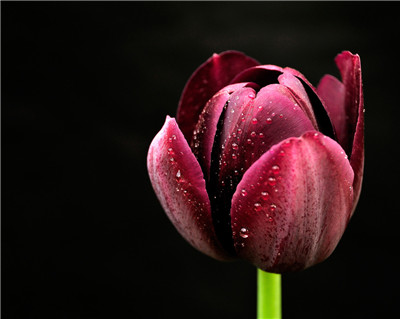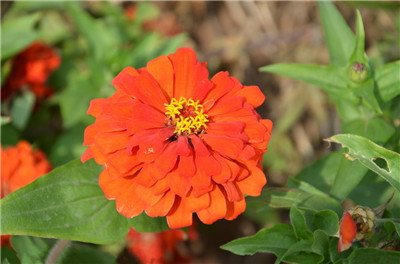Some Experiences in Tulip Cultivation
Tulips with beautiful flowers and beautiful plants are common ornamental plants. This year, it is very popular to enter the fresh cut flower market. Moreover, the long and elegant pedicels of tulips are good materials for flower arrangement. The market prospect of tulips is broad, so we should pay attention to the following when cultivating tulips.
1. It is required to grow in sandy loam soil with good drainage and high content of humus, and a small amount of compost and bone powder can be mixed as base fertilizer.
2, the nature likes cool, but the adaptability is strong, not only can face the wet cold in winter, but the summer should not exceed 27 degrees Celsius, the temperature is too high, it will make the leaves grow excessively, the proportion of leaves and flowers is out of proportion, and the flowering is bad; the suitable temperature for growth is 15-20 degrees Celsius, above 8 degrees Celsius, it can grow normally, but it can also withstand the low temperature of-14 degrees Celsius.
3. Keep moist during the growing period, except for proper watering during drought, it does not need a large amount of watering; in winter, it mainly grows roots and grows slowly, but it can not be watered or rarely watered; spring is the peak growth period for buds and leaves, which can be watered appropriately; long balls are mainly used after flower fade, and the water should be properly controlled.
4. if the light is sufficient, the flowers can bloom well, and the viewing period of flowers can be prolonged, but if the light is not enough, the flowers will not bloom enough or even close.
5. Topdressing should be carried out in important growth periods such as seedling emergence, bud formation and flowering. Diluents such as sesame sauce residue, mandarin water and ferrous sulfate can promote its growth, and urea should not be used in topdressing.

6. For the purpose of cultivating bulb roots, the flower buds should be removed immediately to avoid the consumption of nutrients, while those for cut flower production can be cut off when the buds change color completely.
7, flowers appear pattern, caused by virus infection, should be immediately dug up and burned, so as not to spread the infection.
8. Reproduction: sowing and reproduction-it is used in breeding and mass reproduction. But it takes 4 ~ 5 years for the bulb to blossom, so the bulb is mainly separated as follows:-the annual mother ball germinates 1-3 new bulbs and 2-6 bulbs at the base of the bulb after flowering, while the mother ball gradually dries up, can dig out the bulb, remove the soil to dry, separate the bulb and store it in a ventilated place of 510 degrees Celsius. In September of autumn, the bulbs can be planted in the soil rich in decaying leaf soil and appropriate amount of phosphorus and potassium fertilizer, with a row spacing of 14,16cm, a ditch depth of 1520cm and a covering depth of 4cm. However, it should be noted that if the bulb is round, it can blossom even though it is small, but if the bulb is flat, it will not blossom. After planting, the bulbs should be watered thoroughly and kept moist at ordinary times. In the next spring, the seedlings began to carry out normal fertilizer and water management and blossomed for 2 ~ 3 years.
9, promote cultivation: in order to supply the needs of the Spring Festival, you can choose early flowering varieties, planted in the hotbed or greenhouse in early October, moved into the greenhouse in early December, daily wine-water, 20 days or so can bud, if you want to advance, the greenhouse temperature should be kept at 16-18 degrees Celsius, and the surrounding cover, so that the sun can not be seen, two weeks later in a sunny place, and appropriate cooling, six weeks after flowering.
Culture skills of Tulip
Click on the picture to go to the next page > >
Next, let's discuss how to maintain the "queen of flowers in the world".
Looking at the essence from the phenomenon, in order to preserve a kind of plant, it is necessary to proceed from its essence. Tulips are native to the alpine regions of Iran and Turkey. Due to the climate of the Mediterranean, tulips adapt to cold and wet winters and dry and hot summers. > > more
The main results are as follows: 1. The method of propagation is to separate bulbs. The annual mother ball germinates 1-3 new bulbs and 2-6 bulbs at the base of the bulb after anthesis. > > more
(1) bulb rot often occurs when tulips are cultivated. The main reasons for this phenomenon are as follows. > > more
(2) pest control of tulips.
The main diseases and insect pests of tulips are rot, Sclerotinia sclerotiorum, virus disease, thrips, eggplant aphids and root lice. > > more
Prevention and treatment of brown spot:
Etiology:
A. the pathogen overwintered in the soil with sclerotia or fungal cords. When the conditions were suitable in the following year, the mycelium produced by Sclerotinia sclerotiorum was initially infected.
B, the filamentous hyphae produced by the strain extended to contact the neighboring plants or the sclerotia were re-infected by water transmission, resulting in the spread of the disease, continuous cropping or clay weight of the soil and low-lying or high-temperature and humid years or seasons. > > more
Symptoms: the infected leaf buds are malformed and curled, and the leaves that grow up after the tender buds are damaged become curly. If the environment is humid, a large number of gray mold conidia will be produced on the diseased tissue, which will affect the nearby healthy plants and make the leaves susceptible, so the growth of the bulb will be greatly affected. > > more
Etiology: the bacteria can produce conidia when the degree is 5 degrees and the humidity reaches 90% ~ 100%. The disease is serious when it is low temperature in spring and wet in rainy days. > > more
Prevention and treatment of incense black rot:
Symptoms: bulb disease. Stem disc and stem surface, sometimes on the second and third scales, initially yellowish brown and then black irregular disease spots, the surface is rough.
Etiology: the infected bulb and the residual body in the soil are the source of infection. > > more
Culture skills of Tulip
Next, let's discuss how to maintain the "queen of flowers in the world".
Looking at the essence from the phenomenon, in order to preserve a kind of plant, it is necessary to proceed from its essence. Tulips are native to the alpine regions of Iran and Turkey. Due to the climate of the Mediterranean, tulips adapt to cold and wet winters and dry and hot summers. > > more
The main results are as follows: 1. The method of propagation is to separate bulbs. The annual mother ball germinates 1-3 new bulbs and 2-6 bulbs at the base of the bulb after anthesis. > > more
(1) bulb rot often occurs when tulips are cultivated. The main reasons for this phenomenon are as follows. > > more
(2) pest control of tulips.
The main diseases and insect pests of tulips are rot, Sclerotinia sclerotiorum, virus disease, thrips, eggplant aphids and root lice. > > more
Prevention and treatment of brown spot:
Etiology:
A. the pathogen overwintered in the soil with sclerotia or fungal cords. When the conditions were suitable in the following year, the mycelium produced by Sclerotinia sclerotiorum was initially infected.
B, the filamentous hyphae produced by the strain extended to contact the neighboring plants or the sclerotia were re-infected by water transmission, resulting in the spread of the disease, continuous cropping or clay weight of the soil and low-lying or high-temperature and humid years or seasons. > > more
Symptoms: the infected leaf buds are malformed and curled, and the leaves that grow up after the tender buds are damaged become curly. If the environment is humid, a large number of gray mold conidia will be produced on the diseased tissue, which will affect the nearby healthy plants and make the leaves susceptible, so the growth of the bulb will be greatly affected. > > more
Etiology: the bacteria can produce conidia when the degree is 5 degrees and the humidity reaches 90% ~ 100%. The disease is serious when it is low temperature in spring and wet in rainy days. > > more
Prevention and treatment of incense black rot:
Symptoms: bulb disease. Stem disc and stem surface, sometimes on the second and third scales, initially yellowish brown and then black irregular disease spots, the surface is rough.
Etiology: the infected bulb and the residual body in the soil are the source of infection. > > more
- Prev

Cultivation and management of cyclamen
Cyclamen is a relatively delicate flower species, which is susceptible to disease and requires fine maintenance. However, because of its bright and rich colors, long flowering period, thick leaves and high ornamental value, cyclamen is a good gift to relatives and friends and a good gift for blessing. It is also an excellent potted flower placed in living rooms, conference venues and hotels.
- Next

Maintenance skills of zinnia
The following points should be paid attention to in the process of raising flowers: like light: like warmth, avoid extreme heat, withstand early frost, and require fertile and moist soil to significantly reduce the quality of flowering in barren and dry soil. Temperature: the hundred-day grass likes to be warm and sunny, can not bear the heat, high temperature and cold.
Related
- Fuxing push coffee new agricultural production and marketing class: lack of small-scale processing plants
- Jujube rice field leisure farm deep ploughing Yilan for five years to create a space for organic food and play
- Nongyu Farm-A trial of organic papaya for brave women with advanced technology
- Four points for attention in the prevention and control of diseases and insect pests of edible fungi
- How to add nutrient solution to Edible Fungi
- Is there any good way to control edible fungus mites?
- Open Inoculation Technology of Edible Fungi
- Is there any clever way to use fertilizer for edible fungus in winter?
- What agents are used to kill the pathogens of edible fungi in the mushroom shed?
- Rapid drying of Edible Fungi

